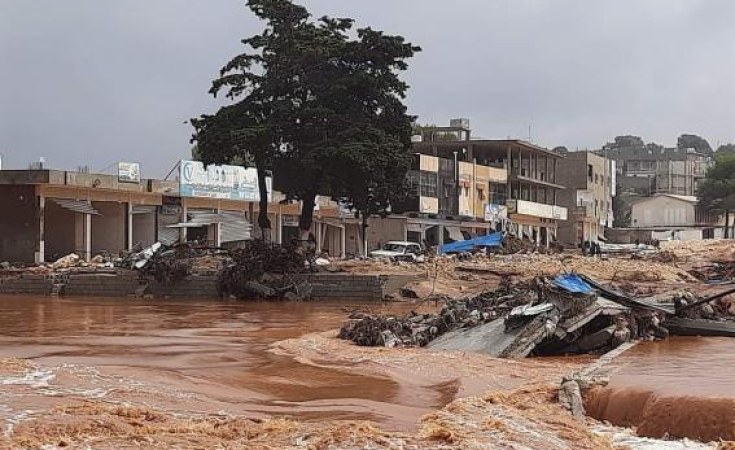In the aftermath of a devastating flood in Libya, the threat of more dam failures looms. As bodies are collectively buried, survivors face the risk of displaced land mines and contaminated water.
A week after a catastrophic flood devastated Derna, a coastal city in Libya, affected regions are still threatened by more dams breaking due to rising water levels.
The disaster has claimed thousands of lives, and many remain missing. As the deceased are interred in collective burial sites, survivors are confronted with a challenging decision: whether to stay near the flooded region, risking infectious disease and water shortage, or to flee through areas where the torrential waters may have dislodged land mines.
Here are the latest developments from Libya's flooded areas.
More dams at risk?
The United Nations Office for the Coordination of Humanitarian Affairs (OCHA) issued a warning on Saturday indicating that two additional dams in eastern Libya might be at risk of imminent failure due to rising water levels.
This comes a week after Storm Daniel led to the collapse of the Abu Mansour and Derna dams, unleashing destructive torrents of water upon the city of Derna.
The OCHA noted that there are "conflicting reports" surrounding the condition of the Jaza dam, situated between Derna and Benghazi, and the Qattara dam, located near Benghazi.
Over the past five days, Libyan and international media have reported rising water levels and potential structural damages at these two dams, raising fears that another tragedy similar to the deadly flooding in Derna might occur.
Nevertheless, some reports suggest that authorities have taken proactive measures to mitigate the risk, including installing pumps at the Jaza dam to alleviate the pressure on its structure and ordering the evacuation of nearby villages and towns.
Claudia Gazzini, an analyst from the Crisis Group currently in the flooded areas, personally visited the Wadi Qattara dam on Thursday to assess the situation and provide clarity. She shared her findings via the social media platform X.
"Given the disinformation circulating, today I decided to check in person on the state of Wadi Qattara dam near Benghazi," she wrote.
Accompanying her tweet was a video from the dam suggesting the situation was under control. "See for yourself: all is fine," Gazzini wrote.
Mass graves
The UN reported that more than 1,000 individuals have been laid to rest in communal burial sites, raising concerns among human rights groups about the potential psychological distress inflicted upon the families of the deceased.
While some aid organizations worry that mass burials may heighten the risk of water contamination and the spread of infectious diseases, Dr. Melanie Klinkner, a Professor of International Law from Bournemouth University, believes this is primarily the case when deaths are attributed to contagious diseases.
"Dead bodies only pose risks if the deaths result from highly infectious diseases. It is, of course, possible for diseases to be transmitted by the surviving population due to inadequate sanitation," she told DW.
However, "the distress the lasting mental health issues caused by the improper handling of human remains should not be underestimated as a health concern."
From a human rights perspective, ensuring dignified handling for future identification is imperative, Klinkner said, emphasizing the importance of implementing the World Health Organization and Interpol guidelines and regulations to ensure that the bodies are treated with dignity and can be identified later.
These guidelines entail measures such as assigning a unique code to each body, promptly capturing photographs, recording relevant data for each individual and securely placing each body in a body bag, Klinkner explained.
Displaced land mines and contaminated water
Flood survivors in Derna now confront the danger of displaced land mines in the surrounding areas.
Libya has been littered with land mines and other explosive. While some unexploded munitions date back to World War II, many more have been planted by rebel groups, government forces and the Russian private military company Wagner Group since 2011, when the civil war broke out in the oil-rich country.
Libya has one of the highest numbers of land mine casualties in the world. Nearly 3,500 Libyans have been killed by mine explosions between 2011 and 2021, according to a UN report.
With thousands of displaced people and aid workers on the move, the risk of land mine exposure is rising, OCHA's report said.
The International Committee of the Red Cross (ICRC) said their team is assessing the risk posed by unexploded ordnance and abandoned munition stores in Derna to prevent further death and injury.
The survivors, 30,000 of whom have been displaced in Derna alone, need clean water as the flood has damaged and contaminated the water network.
Libyan health authorities have reported over 150 cases of diarrhea, with at least 55 children suffering from poison from polluted water in Derna.
Edited by: Davis VanOpdorp


